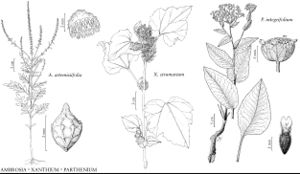Difference between revisions of "Xanthium strumarium"
Sp. Pl. 2: 987. 1753.
FNA>Volume Importer |
imported>Volume Importer |
||
| (2 intermediate revisions by 2 users not shown) | |||
| Line 8: | Line 8: | ||
}} | }} | ||
|common_names=Cocklebur;lampourde glouteron | |common_names=Cocklebur;lampourde glouteron | ||
| + | |special_status={{Treatment/ID/Special_status | ||
| + | |code=F | ||
| + | |label=Illustrated | ||
| + | }} | ||
|basionyms= | |basionyms= | ||
|synonyms={{Treatment/ID/Synonym | |synonyms={{Treatment/ID/Synonym | ||
| Line 118: | Line 122: | ||
|publication title=Sp. Pl. | |publication title=Sp. Pl. | ||
|publication year=1753 | |publication year=1753 | ||
| − | |special status= | + | |special status=Illustrated |
| − | |source xml=https:// | + | |source xml=https://bitbucket.org/aafc-mbb/fna-data-curation/src/2e0870ddd59836b60bcf96646a41e87ea5a5943a/coarse_grained_fna_xml/V19-20-21/V21_27.xml |
|tribe=Asteraceae tribe Heliantheae | |tribe=Asteraceae tribe Heliantheae | ||
|subtribe=Asteraceae (tribe Heliantheae) subtribe Ambrosiinae | |subtribe=Asteraceae (tribe Heliantheae) subtribe Ambrosiinae | ||
Latest revision as of 20:11, 5 November 2020
Plants 10–80(–200) cm; nodal spines 0. Leaves: petioles 20–100(–140+) mm; blades suborbiculate to ± pentagonal or deltate, 4–12(–18+) × 3–10(–18+) cm, sometimes palmately 3–5-lobed, abaxial faces green, hirtellous. Burs 10–30+ mm. 2n = 36.
Phenology: Flowering Jul–Oct.
Habitat: Damp or seasonally wet, often alkaline, soils, waste places, margins of agriculture
Elevation: 10–2000 m
Distribution

Alta., B.C., Man., N.B., N.S., Ont., P.E.I., Que., Sask., Ala., Alaska, Ariz., Ark., Calif., Colo., Conn., Del., D.C., Fla., Ga., Idaho, Ill., Ind., Iowa, Kans., Ky., La., Maine, Md., Mass., Mich., Minn., Miss., Mo., Mont., Nebr., Nev., N.H., N.J., N.Mex., N.Y., N.C., N.Dak., Ohio, Okla., Oreg., Pa., R.I., S.C., S.Dak., Tenn., Tex., Utah, Vt., Va., Wash., W.Va., Wis., Wyo., Mexico, Central America, South America, widely introduced in Old World.
Discussion
Recognition of a dozen or more taxa (treated as species, subspecies, varieties, and/or forms) has been proposed for plants treated together here as Xanthium strumarium. Bases for the various taxa mostly involved subtle differences in the burs.
Selected References
None.
